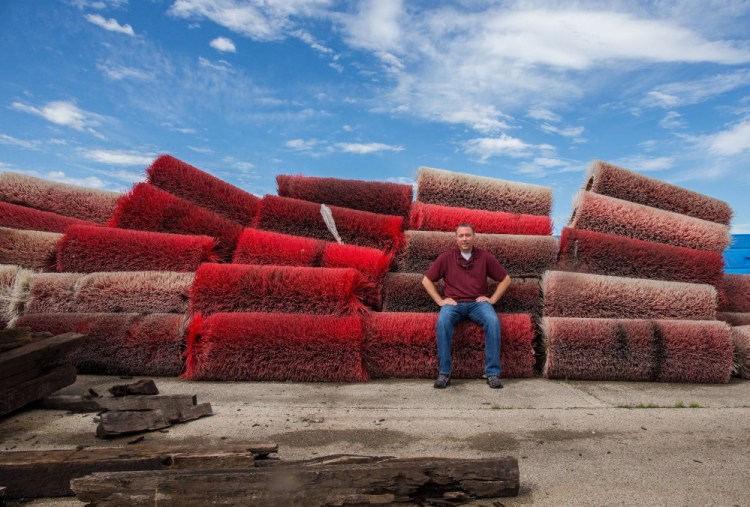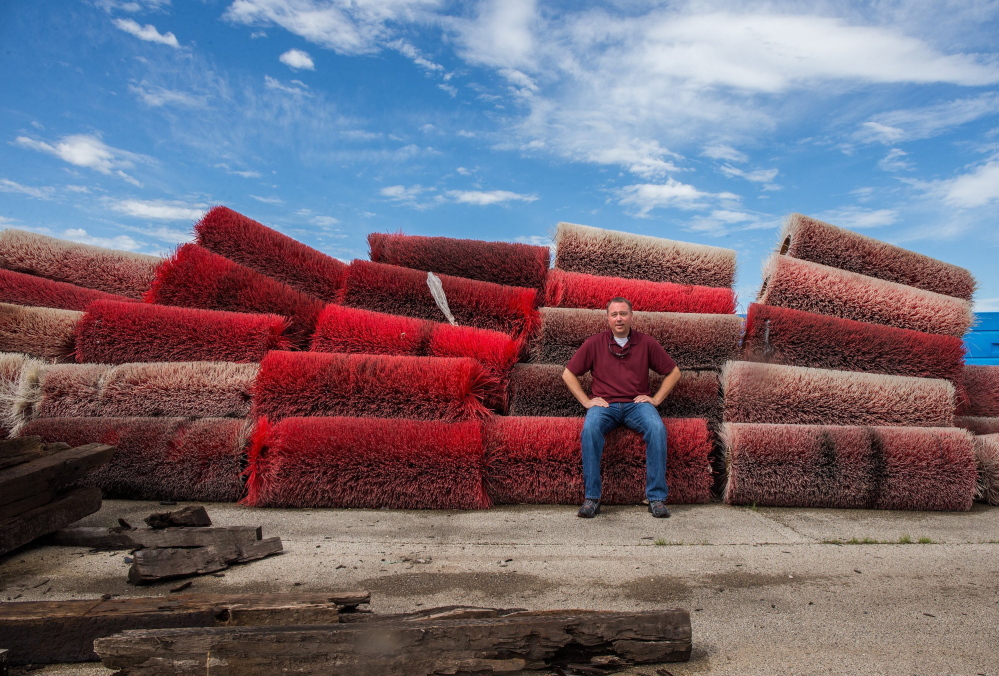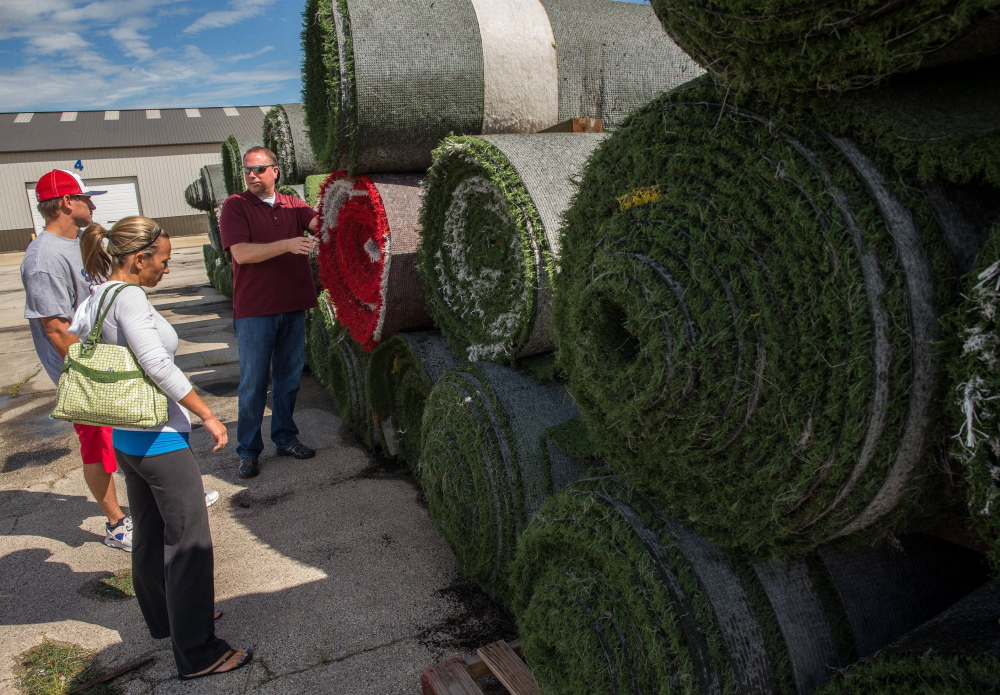What do you do with 15,000 feet of old fire hose?
Hammer it onto docks as boat bumpers. Weave it together for jungle gyms. Stretch it into horse fences. Cut it into pieces to sharpen straight razors.
Welcome to repurposing – finding new uses for items at the end of their lives.
Repurposing isn’t new. Artists have long fashioned sculptures and other works out of what most people would consider junk. But repurposing typically involves large volumes of materials like thick wooden beams from old factories, artificial football field turf or piles of street sweeper brushes.
The growing popularity of repurposing among farmers, builders and manufacturers has given rise to middleman businesses that specialize in selling such materials they buy or get for free or were paid to haul away – businesses like Colorado-based Repurposed Materials.
“These big manufacturing companies, they have huge disposal problems, and it’s not cool anymore to throw stuff away,” said Damon Carson, who owns Repurposed Materials. The thinking of manufacturers today, he said, is, “I could throw this away or do a deal with Repurposed Materials and tell our shareholders (and) customers that we’re closer to zero waste.”
Brenda Pulley, senior vice president of recycling for the national nonprofit Keep America Beautiful, said there is “a shift from thinking of it as waste to thinking about what value does that item have? How do we repurpose it, reuse it and get it back in the economy?”
Repurposing is new enough that it has not been studied. Seven states have chapters with the national Reuse Alliance, which is seeking funding to establish regional and national data on reuse. “A reuse could be you donate a computer and someone gets to use it,” Pulley said.
A 2011 Minnesota study suggests that sparing junk from landfills can contribute a lot to its economy. The report estimated that its reuse sector, which includes items such as used cars, generates $4 billion in gross sales annually, 1.6 percent of the state’s gross domestic product.
The story of how Repurposed Materials obtained the fire hose illustrates how repurposing benefits all parties involved.
Carson bought 15,000 feet of fire hose from the city of Chicago for less than $1,000 in an online auction, he said. So far, he has sold about 7,000 feet at 50 cents a foot, reaping a tidy profit.
On the selling side, Chicago saved an estimated $350,000 on hauling and dumping fees, said Cathy Kwiatkowski, a spokeswoman for the Department of Procurement Services.
On top of that, the city made money selling the hose as well as thousands of other unwanted items. Chicago has collected more than $11 million in more than 2,000 online auctions since 2011, Kwiatkowski said.
Carson said his customers come from a range of industries (cranberry farmers, copper miners, golf course owners) but have characteristics in common: innovativeness, resourcefulness and frugality.
A case in point is Brandon Weiss, a home builder who bought a few rolls of Harvard University soccer field turf to cover mud surrounding a house he was staging to sell.
“We used the turf as a way to soften up the construction phase,” Weiss said. “Now, we’re using it as a walkway between raised garden beds.”
Then there’s Mike Brandonisio, owner of a razor-sharpening business. He bought 50 feet of used fire hose, though he doesn’t take credit for being innovative. He said repurposing fire hose to make into strops to sharpen straight razors dates to the 1800s.
The fire hose side, he explained, chisels off microscopic amounts of metal, and a leather flip side smooths it out.
“It’s one of the things people in the shaving community look for,” Brandonisio said, “in terms of marks of quality.”
One upside of repurposing is that it can be inexpensive.
On a recent weekday, a couple visited Repurposed Materials’ Chicago-area location, where branch manager Jerry Kessler showed them AstroTurf obtained from a high school in the city.
Brian Zirkle and Michelle Anderson plan to open a sports training facility. They walked between rows of green turf, spotted with red, which had been in the school’s end zone.
“How much is it?” Anderson asked. When Kessler told her $187, Anderson said she had been expecting it to cost a lot more: “Are we missing some zeros here?”
The couple didn’t buy the turf on the spot, but said they would return after looking at pictures of the school’s old field.
Chris Franks, president of Ohio-based Sports Contracting Group, paid Repurposed Materials to remove the approximately 90,000 square feet of turf, he said. Franks installed new turf at the high school’s football field in mid-August.
Had he not found Repurposed Materials, Franks said, he would have sent the entire field of polyethylene fibers and crumbled rubber infill to the landfill.
“There’s really not a whole lot of options for it,” Franks said. “The No. 1 way to dispose of it is a landfill.”
Carson declined to provide sales or profit information other than to say it took him two years for Repurposed Materials to break into the black. His Colorado business has seven employees, and he has one employee and a temporary employee in Illinois.
Carson once was the guy who put junk in landfills. But then he bought a business called Kiddie Rides USA, which restored old carousel seats and coin-operated horse rides.
An airbrush artist he worked with suggested that he buy old vinyl from advertising billboards to use as dropcloths. He did, and afterward discovered that he could resell them to local artists and other business owners at a profit.
“There was no grand vision at that point,” Carson said.
Four years later, Kessler of Repurposed Materials’ walked past piles of neatly folded vinyls at the Chicago-area location. People buy the sheets of vinyl at prices from $50 to $100, for reuse as pond liners, boat covers, slip-and-slides and for backyard movie screens, Kessler said.
The 10,000-square-foot location was formerly a lumberyard. The company hosts auctions every couple of months to help move out old inventory. But on a recent visit, rolls of AstroTurf, gymnasium floors, billboard vinyl, conveyor belts, galvanized steel cable and street sweeper brushes filled the space.
Farmers buy the brushes for reuse as cattle back-scratchers.
“They take the big brush and put it on a big pole (or) hang it from a tree or fence or something,” Kessler said of the prickly red cylinders with steel cores. “And when your cows or horses have an itch, they go and rub up against it.”
Kessler said he also has large drums of “harvest berry” fragrance that had been intended for shampoo.
“It makes the warehouse smell really good while it’s here, but (I’m) not sure what we’re going to do with that,” Kessler said, laughing. “But that’s kind of what the cool part of the job is. You never know who’s going to call, what’s going to show or what you’re ultimately going to do with it.”
One industry bolstered by repurposing is construction and remodeling. Repurposing items in homes can add to their value, some in the industry said, while donating items can give homeowners something to write off on their taxes.
Steve Filyo, founder of Pursuit of Consciousness, known as POC Deconstruction and Salvage, “deconstructs” homes. He said he preserves items during demolition, and homeowners donate them to a nonprofit that repurposes them. Lumber is almost always repurposed.
“We’re trying to put together a network of artists and craftsmen who would value that these things could become something else,” he said.
Gary Marks, a former Chicago antiques dealer, said he likes to incorporate repurposed items in the Chicago houses he renovates. Some examples: a chandelier made from operating room surgical lights and an iron fire safe door turned into a hallway closet door, adding value to the home.
“Everybody sells Chicagoans the same thing. … Somebody flips the switch, like it was with granite-top counters and stainless steel appliances,” Marks said. “When you show them something different, they go, ‘Wow, that is cool.’ “
Copy the Story LinkSend questions/comments to the editors.





Success. Please wait for the page to reload. If the page does not reload within 5 seconds, please refresh the page.
Enter your email and password to access comments.
Hi, to comment on stories you must . This profile is in addition to your subscription and website login.
Already have a commenting profile? .
Invalid username/password.
Please check your email to confirm and complete your registration.
Only subscribers are eligible to post comments. Please subscribe or login first for digital access. Here’s why.
Use the form below to reset your password. When you've submitted your account email, we will send an email with a reset code.